Both Corian and high pressure laminate are worthy options for your new kitchen countertop. Still, each product has distinct advantages over the other.
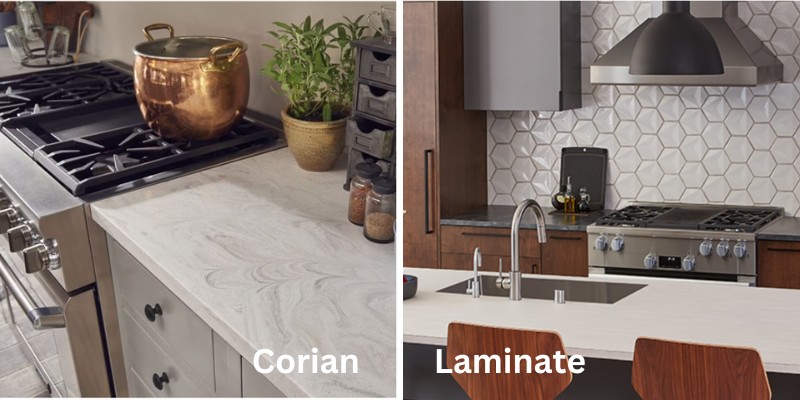
Here I compare Corian to laminate on their performance and aesthetics. You’ll discover which material has more durability, longevity, and design options. You’ll also learn which one is most affordable and easier to install.
Whichever product you choose, your kitchen will look exquisite!
What is Corian?
Corian consists of natural minerals and acrylic polymers. As a “solid-surface material,” it’s dense and consistent throughout. Corian sheets come in thicknesses of ¼ inch, ½ inch, and ¾ inch.
Which companies make Corian countertops?
DuPont created and patented Corian in 1971. Subsequently, DuPont lost the patent, and other versions came to the market, designed by Wilsonart and Avonite.
Still, Corian is the brand name for this solid-surface product. Moreover, only DuPont-certified employees can install Corian countertops.
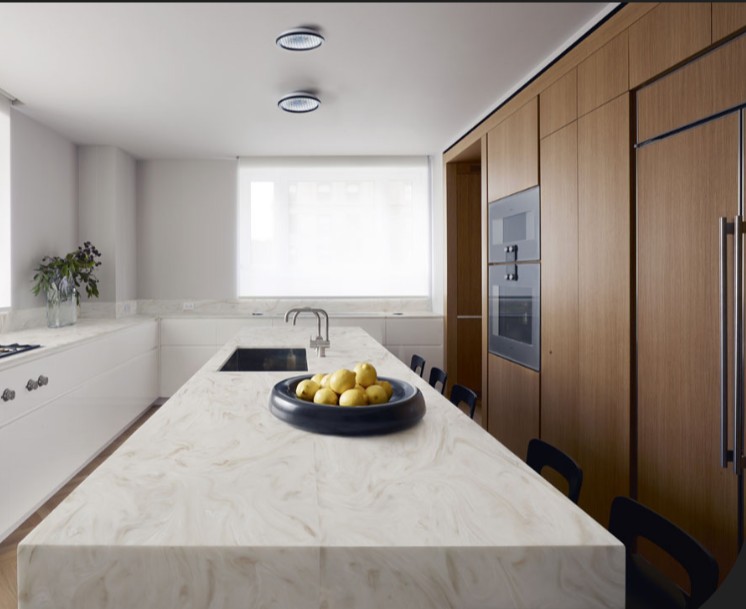
Image Source: Corian
What is laminate?
Laminate is a top-surface material made of plastic phenolic resins. The base layer is called a substrate and is usually made from paper.
Options include medium-density fiberboard (MDF), plywood, Kraft paper, or composite wood panels. Laminate sheets can be 1½ or 2 inches thick.
Manufacturers produce laminate by infusing plastic resins with cellulose. Then, they apply pressure and heat to the layers, causing them to solidify. Hence the name, “high pressure laminate,” abbreviated HPL.
Then, manufacturers add a decorative print layer, covering it with a protective melamine resin.
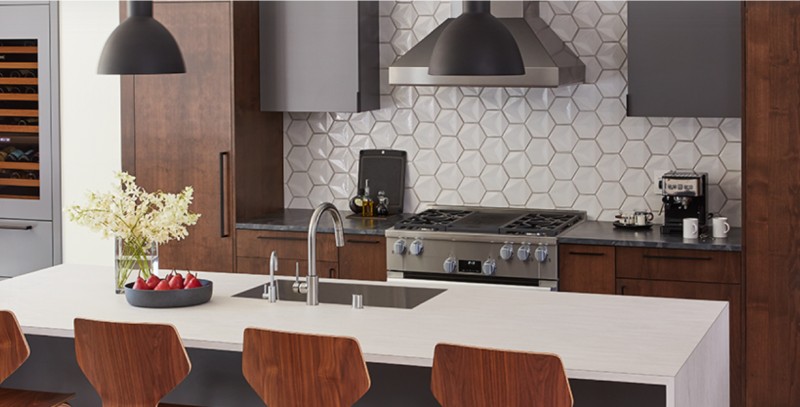
Image Source: Formica Laminate
Which companies design laminate kitchen countertops?
Currently, the leading manufacturers of HPL are Formica, Wilsonart, and Nevamar.
Laminate was invented in the early 1900s, predating Corian. Today’s HPL is vastly improved in durability, scratch resistance, and available styles.
Comparison of Corian Vs Laminate Countertops
Design Options
Corian can be molded into any shape, including fluid designs. Thus, you can easily integrate a Corian countertop with sinks, fixtures, single and double basins, and backsplashes. Moreover, you can have Corian engraved, textured, or polished.
Meanwhile, laminate comes in gorgeous graphics, thanks to the latest printing technologies. Examples are abstract images, wood grains, stone patterns, and textured prints. Laminate countertops can even simulate marble and granite!
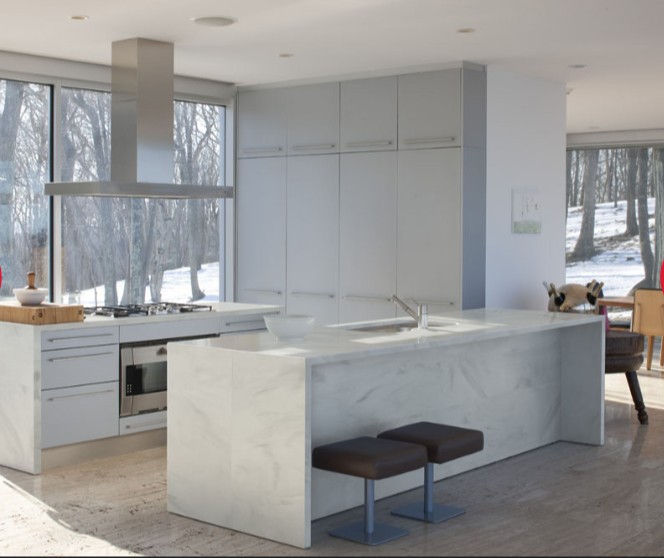
Corian
Spectrum of Colors and Finishes
Corian countertops are available in approximately 100 different colors. Due to the natural minerals in Corian, patterns and hues can vary slightly between sheets.
You can also choose from three types of finishes – matte, semi-gloss, and high-gloss. Generally, light-colored panels have a matte surface. Conversely, dark countertops can display either a semi-gloss or high-gloss finish.
Still, laminate comes in more colors than Corian. Moreover, each laminate producer offers distinct, proprietary finishes with unique names.
For instance, with Formica laminate, choose from six finishes, including crystal, artisan, etchings, and radiance. Meanwhile, Wilsonart provides 10 countertop finishes. Among them are fine velvet, quarry, textured gloss, and high-definition glaze.
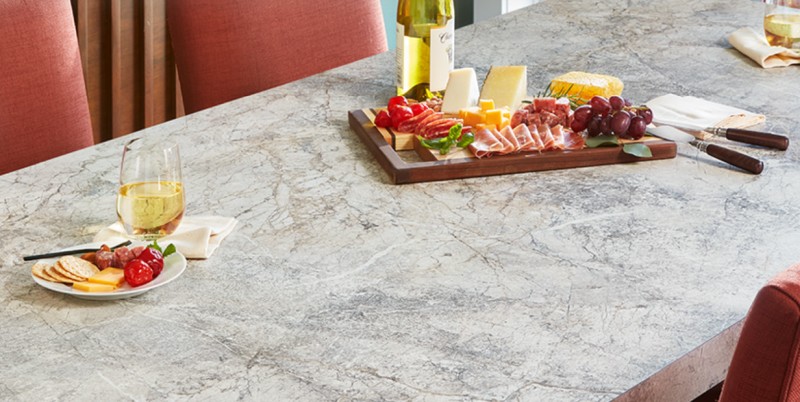
Formica Laminate
Durability
As a solid-surface material, Corian is much stronger than laminate. So, if Corian gets chipped, you can fill the cavity. On the other hand, you can’t repair nicks on laminate.
Additionally, Corian is seamless. Manufacturers smooth the panel ends, attaching them with caulking and adhesives and sealing them with heat. Hence, you won’t see any joints in a Corian countertop.
Meanwhile, laminate panels have visible joints. If water collects in the seams, the plastic resins can deteriorate.
If you see the layers separating at the edges, the countertop needs replacing. You can prevent this by drying the surface and edges whenever they get wet.
Heat Tolerance
Both Corian and laminate surfaces can handle moderate heat. Still, hot cookware renders permanent tarnish and burn marks.
To prevent scorching, rest hot kitchenware on a protective barrier, such as a silicone mat. This material can weather temperatures up to 450 degrees F.
Also, keep silicone trivets under heat-generating appliances, such as a microwave oven or toaster.
Scratch Resistance
Both Corian and laminate are vulnerable to scratches. Still, you can sand or polish Corian to banish them. You can also fill small holes and gouged areas.
Conversely, on laminate, you can’t fix chips, deep scratches, and abrasions. Still, if a laminate counter has surface scrapes, you can hide them with resin paint.
Whether you choose Corian or laminate, shield your worktop from scratches by using a cutting board. Additionally, avoid dragging rough items over the surfaces.
Maintenance
Laminate and Corian countertops are equally stain-resistant.
While Corian repels bacteria and mold, water residues can leave a film. So, dry the worktop whenever it gets wet. Otherwise, the film will thicken, turning the finish dull or blotchy.
Also, try to wipe up spilled liquids as they occur.
How to Clean a Corian Countertop
First, apply warm soapy water or an ammonia-based cleaner. Then, rinse off the cleanser and dry the counter completely. You can eliminate hard water marks with a commercial product designed for this purpose. Examples are Lime-A-Way and CLR.
If the counter has deep-set stains, you can sand them out.
To disinfect a Corian countertop, apply diluted bleach, combining five tablespoons of bleach with one gallon of water. After rinsing the surfaces well, dry them thoroughly. Avoid disinfecting Corian daily to protect its finish.
Caution: Acid drain cleaners may cause surface damage and should not be used on Corian surfaces.
How to Clean a Laminate Countertop
Compared to Corian, laminate worktops are much easier to clean. First, apply a solution of warm water and dish soap with a sponge. Then, rinse and dry all the surfaces completely.
To remove stains, mix one tablespoon of baking soda with two tablespoons of water. Next, spread the paste on the stain, leaving it for five minutes. Then, rinse and dry the counter with a soft, damp cloth.
Caution – Avoid using abrasive cleaners and scrubbers on Corian and laminate surfaces. Also, note that bleach will damage a laminate countertop, unlike Corian.
Longevity
Generally, Corian outlasts HPL. Still, with diligent care, a laminate kitchen countertop has a lifespan of about 15 years.
Most Corian worktops come with a 10-year manufacturer’s warranty. Still, in practice, Corian countertops endure for at least 30 years. Hence, they have twice the longevity of laminate kitchen counters.
Installation
Laminate panels are flexible, lightweight, and relatively simple to install. So, if you’re handy and have the required tools, installation should go smoothly.
While Corian countertops are cumbersome, you can likely install one with the help of a tutorial.
Pricing
Corian Countertop
This material is more expensive than laminate. Prices for Corian worktops range from $40 to $65 per square foot, uninstalled.
Costs vary by the product’s thickness, style, finish, and color. The thicker a Corian slab, the greater its durability. Thus, ¾-inch material costs more than ¼-inch Corian.
Meanwhile, light hues, such as gray and white, fetch lower prices. Yet, darker colors, like green, black, and blue, are more expensive. That’s because dark colors require more pigments and processing.
If you hire a professional Corian installer, expect to pay between $50 and $80 per square foot. Typically, these rates include the labor to remove and discard an existing countertop.
How to Save Money on Corian
If possible, schedule your project for the fall or winter. Prices for Corian and contractor installation are lower during the off-season.
Then, if you plan on self-installation, compare the cost of materials at a few home improvement stores. Or, if you aim to hire an installer, get quotes from at least three contractors.
Whatever your final cost, a Corian countertop should have twice the lifespan of a laminate one. Thus, you’ll save money in the long run.
Laminate Countertop
The cost of laminate ranges from $10 to $40 per square foot for the material alone. Prices vary by your chosen type of edging, substrate, and finish.
Most professional installers charge between $20 and $80 per hour for materials and labor. Usually, this includes the cost to remove and discard an existing countertop.
Final Assessment
Let’s review the factors to consider for your countertop and the optimal material in each category.
- Durability – Corian
- Array of Design Choices – laminate
- Spectrum of Colors and Finishes – laminate
- Heat Tolerance – Corian and laminate are equal, needing protection
- Scratch Resistance – Corian
- Less Maintenance – laminate
- Longer Lifespan – Corian
- Ease of Installation – laminate
- Budget-Friendly – laminate
Thus, both Corian and laminate are high-quality materials for kitchen counters. Each product will serve you well!
Image Sources
Related Posts
- 11 Ways to Get Rid of Cooking Smells in a Small Apartment or House
- All About Fragranite Kitchen Sinks With Pros & Cons
- Comparison of Granite Composite Sink vs Stainless Steel
- How Much Does it Cost to Paint Kitchen Cabinets?
- What Color Granite Goes With Maple Wood Kitchen Cabinets?
- What Color Granite Goes With White Cabinets – Some Design Ideas
Leave a Reply